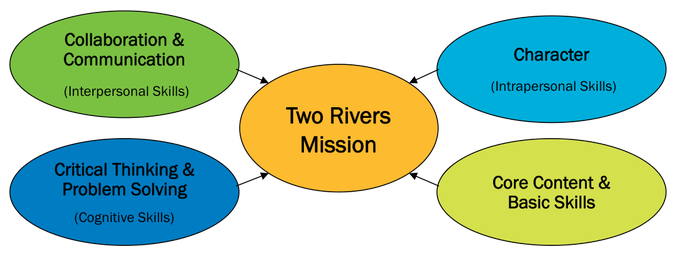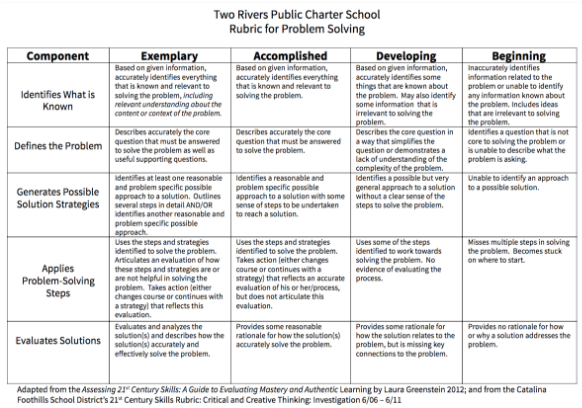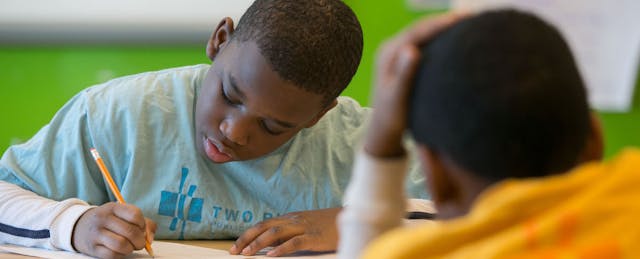Two Rivers Public Charter School welcomed its first class of students in the fall of 2004, after more than three dozen parents from the Capitol Hill neighborhood came together to write the charter. Today, the school, based in Washington D.C., serves over 700 students across three campuses from Pre-K through eighth grade.
Part of the EL Education network (formerly Expeditionary Learning) since it’s inception, Two Rivers opened as an expeditionary and project-based learning school. The student experience in an EL environment is closely aligned with Outward Bound’s educational philosophy, which emphasizes character, leadership and service. “Our goal is to develop socially and emotionally competent kids who can navigate the world with flexibility,” explains Jeff Heyck-Williams, director of curriculum and instruction for Two Rivers.
From the start, the founders of Two Rivers recognized that teaching academic skills was not enough, but they struggled to identify which non-academic skills to focus on. Since the school opened, its leaders have been on a mission to develop a broad vision of student success and to implement a school model that supports the skills and habits they believe contribute to that vision.
Over time, they have learned that some of the skills that are most critical for success are difficult to teach and even harder to assess. It’s not always as simple as purchasing a curriculum, or even modifying an existing set of assessments, because in many cases, these materials don’t yet exist. This might deter some school communities from moving forward, but the staff at Two Rivers is committed to bringing their vision to life, so when the resources don’t exist, they roll up their sleeves and build them from scratch.
Defining Student Success through Four Dimensions
Shortly after opening the school, the founders of Two Rivers began researching the non-academic skills students needed to be successful. Their findings shaped a new definition of student success, which encompasses four broad dimensions: core content & basic skills, critical thinking & problem solving, collaboration & communication, and character. While the identification of the dimensions was a step forward, it raised logistical questions for teachers about how to teach and assess these skills in the classroom.
These questions drove the school to create a set of “scholarly habits,” which grew into a social and emotional (SEL) curriculum that served two of the four dimensions: collaboration & communication and character. (Heyck-Williams says the school already had a strong foundation in core content & basic skills.) This left Two Rivers with the challenge of figuring out how to define, instruct and show growth in the final dimension, critical thinking & problem solving, which was the least fleshed out.

Tackling Critical Thinking & Problem Solving
With definitions, curriculum and assessments already in place for the other three dimensions, Two Rivers set out to unlock the mystery of showing student growth in critical thinking & problem solving. After a year-long study in 2010, the school determined that this final dimension includes five components: schema development, metacognition and evaluation, effective reasoning, problem solving and creativity.
From 2010 to 2013, Heyck-Williams created a series of rubrics that aligned with each of the five components, and refined them with feedback from teachers. After many iterations, he settled on scoring each category as Beginning, Developing, Accomplished or Exemplary. (Below, see the problem solving rubric, which Two Rivers teachers use once a month with classroom assignments.)

With the rubrics in place, the next step was to build assessment tasks to measure the specific components, but this was a complex process and the school needed support. During the 2014-2015 school year, Two Rivers was awarded a planning grant from Next Generation Learning Challenges (NGLC) and Citybridge Education through their joint school-catalyzing initiative, Breakthrough Schools: DC. The grant allowed Two Rivers to partner with the Stanford Center for Assessment, Learning, and Equity (SCALE) to design assessment tasks that would measure whether students could apply the problem solving skills they were learning in class to novel sets of information that weren’t testing specific academic skills.
Heyck-Williams and Jill Clark, a middle school social studies teacher with a curriculum development background, worked closely with the SCALE team to lead several teachers in building the assessments tasks in the summer of 2015. The tasks were then piloted and revised during the school year.
In 2016, a second grant from the Assessment for Learning Project from NGLC allowed Two Rivers to continue partnering with SCALE to test and revise existing effective reasoning tasks and to build new ones for the problem solving component. To date, a total of 15 assessment tasks have been created for grades Pre-K to 8 and all of them are content neutral.
For example, a fourth and fifth grade effective reasoning assessment task asks students to determine how a school should allocate its after-school programs budget based on a set of given information about student interests and activity costs. A fourth and fifth grade problem solving assessment task is to build a boat (with a given set of materials) that will float and hold as many marbles as possible.
Breaking Tradition Comes with Obstacles
After 13 years of practice, Two Rivers still finds challenges in pushing up against the norms of what has traditionally defined student success. “How do we hold true to a broader vision of student success when we are still measured against a state test that in many ways is reductionist?” wonders Heyck-Williams, though he believes that success on the test affords the school the opportunity to push the boundaries of instruction in less traditional areas.
Communicating and selling the necessity of educating students in multiple dimensions is also a struggle. Heyck-Williams explains that parents have high expectations for academic rigor because Two Rivers has consistently been ranked as a Tier 1 school by the DC Public Charter School Board. “They aren’t aware of how character, communication, collaboration, and problem solving will also serve their children.”
Forging Ahead to Build Measurement Tools
In addition to collecting and analyzing data from the newly developed assessments, Two Rivers plans to build rubrics and assessment tasks for the remaining three components of critical thinking & problem solving (schema development, metacognition & evaluation, and creativity). This work is projected to happen over the next two years.
Through its work with NGLC, Two Rivers was introduced to MyWays, a next generation learning framework outlining academic and non-academic competencies that support student success. MyWays resonated with the curriculum team. “We immediately saw how well it mirrors the way we think about curriculum, instruction, and assessment,” Heyck-Williams says. “It’s about being really clear on expected outcomes first. Then following up with instruction and curriculum. Then looking at assessment to demonstrate growth.”
The framework reemphasized for Two Rivers the need to measure success across multiple dimensions. As a result, the school is interested in figuring out how to measure habits from its SEL curriculum such as responsibility, independence and teamwork. Heyck-Williams isn’t sure exactly what that evolution of SEL measurement will look like, though he imagines these habits can be assessed by triangulating data from a combination of tools such as surveys, rubrics and the MyWays whole-student competency plot, which he casually refers to as the “spider graph.” This tool provides a visual representation of a learner’s development over time across the set of competencies, indicating strengths and areas for growth.

In an article for EdSurge, Heyck-Williams recently wrote, “We have continued to champion the importance of embracing a broader definition of student success than what has been handed to us by state and national policy. While we believe that it is essential for all students to be proficient in math, literacy, and the sciences, we believe that that is not enough.” Two Rivers remains dedicated to its goal to help learners be successful and flexible in their thinking, and is committed to sharing the school’s methodology through its website Learn with Two Rivers.


